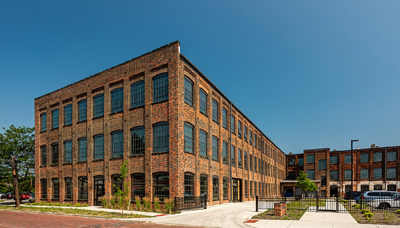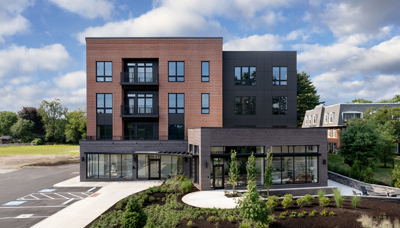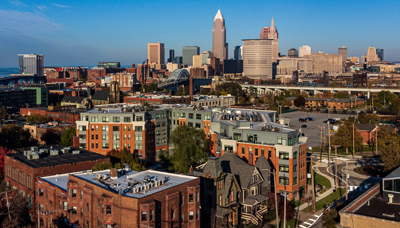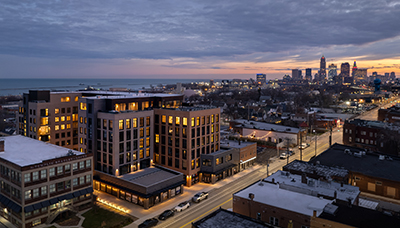Historic Headquarters
Revived 19th-century building in Warren finds new purpose as Wean Foundation home
By Lou Kren I Photos by Jeff Goldberg/Esto Photos
Properties Magazine 2012 08
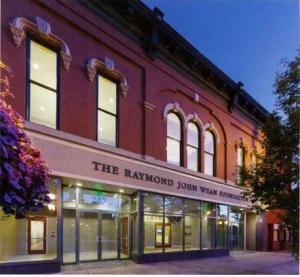
RESTORED & REVIVED Situated in downtown Warren, the renovated, 17,000-square-foot Market Block Building serves as the new home of the Raymond John Wean Foundation.
Listed on the National Register of Historic Places, the Market Block Building on Courthouse Square in downtown Warren was built in 1868. Despite its prominent location directly across from the main entrance to Trumbull County Courthouse, the building meandered through a variety of uses in recent years, ultimately sitting vacant in the late 2000s. Enter the Warren Redevelopment and Planning Corp., which in 2008 purchased the 17,000-square-foot building as part of the city’s program to revitalize the downtown area. Today, the historic building reclaims its lofty status on Courthouse Square as home of the Raymond John Wean Foundation.
The foundation, formed by local industrialist Raymond John Wean in 1949, provides grants totaling $4 million annually to nonprofits in Mahoning and Trumbull counties, with a focus on economically disadvantaged people and neighborhoods, and a goal to renew the Mahoning Valley and expand economic and social opportunities for its residents.
Its new home was made possible through the efforts of The Chesler Group Inc., of Cleveland, which for 25 years has specialized in award-winning restoration of historic structures. The Cheslcr Group purchased the three-level ( basement plus two above-grade floors) building in 2011 specifically to restore it for the Wean Foundation’s use. The restoration team also included Dimit Architects, of Lakewood, as project architect and local client representation by Phillips/Sekanick Architects Inc., of Warren. As a historic-preservation project, The Chesler Group retained Chilcote Law Firm LLP, of Cleveland Heights, as legal counsel with respect to the real estate and historic-tax-credit aspects of Market Block.
Triples former Wean Foundation space
In July, The Chesler Group and the Wean Foundation broke ground for the $2,500,000-plus renovation, culminating in its grand opening on July 18, 2012. The new quarters more than triples the Wean Foundation old office space, located one block away in the Huntington Bank Building. Besides expanded office space for the foundation on the second floor, the building includes a first floor with a seven-office complex for initiatives funded the Wean Foundation. A showcase Of the new headquarters is the storefront Western Reserve Room, a space that can accommodate as many as 120 people for community meetings. It features state- audio-visual equipment and a catering kitchen.
“This
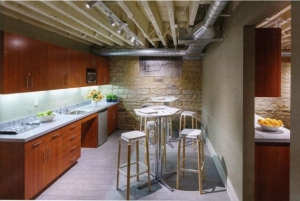
EMBRACING OPPOSITES Spaces on the Garden Level contrast existing stone walls with modern furniture and materials.
“We are especially pleased that The Chesler Group made efforts to engage tradespeople, companies and suppliers,” says Jeffrey M. Glebocki, Wean Foundation president. “This is a project that has and will have great local value. We will be bringing more people downtown and expect a spinoff for local business and restaurants.”
Glebocki says that the first of the foundation-funded programs to be housed in two of the seven first-floor offices is the Trumbull Neighborhood Partnership, which already had been sharing space in the Wean Foundation’s former offices.
The lower level, called the Garden Level, includes a conference room, work room, break room, fitness room and reception area. The offices share portions of the stacked stone outside walls, while the other rooms are clustered in the center.
Wean Foundation space on the second floor includes eight offices, an executive board room, two conference and a central work area.
Surprises brings renovation challenges
To restore Market Block to its historic prominence, designers and constructors studied, planned, dug, salvaged, and hammered and nailed their way through history.
Market Block, when built, consisted of three adjacent structures with low cellars, according to Ben Davis, The Chesler Group construction supervisor. Over time the structures served as dry-goods shops and similar retail establishments. In the early 1900s, the first floors of all three were combined, with steel I-beams providing a base to erect a second floor, bringing the structures to their current configuration as a single two-story building. Storefronts were constructed and modified over the years as the building became a Woolworth’s, a Dollar General and then a candy shop in the 1980s.
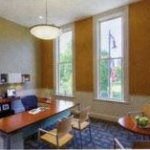
ACCOMMODATING ACTIVITY Tripling the foundation’s old offices, the new headquarters includes eight offices, an executive boardroom, two conference rooms and a central work area.
Mahoning County took over the building and in the 1990s, but eventually, Market Block would sit vacant and in serious need of some TLC.
“When we entered the building in 201 1,” recalls Davis, “the second floor, remaining for the most part as it was in the late 1800s, was very degraded, with some sections such as old showers from the early 1900s completely off.”
Also, sealed-off original skylights featured rotted, sagging frames, and windows — many bricked or tarred over — were in disrepair. Crews quickly went to work, demolishing virtually the entire second floor to expose the original masonry walls and the three original skylight openings.
“We had to replace a significant amount of structural members for the rooftop due to damage,” says Davis. “‘but also to support a new 8,000-pound roof-top HVAC unit.
“During second-floor demolition,” he continues, “we found old doors — with labeling dating to the 1940s — buried in a wall, as well as pocket doors original to the 1868 construction date. We restored all of these doors, including the hardware and re-used them on the second floor.”The process of finding and re-using made for a careful demolition, and kept designers busy.
“Entire spaces were walled in and could not even be accessed,” recalls Scott Dimit of Dimit Architects. “The Chesler Group uncovered and saved a lot of historic elements that we were able to re-use. Luckily, unlike many restoration projects we work on, many old photos of this building were available, which were invaluable during preservation design work.”
A large portion of the first floor space includes the new Western Reserve Room at the front of the building, opening to a glass storefront lobby.
“With the lobby at street level and with people spilling out of that space to the sidewalk. that is a great use of that old commercial storefront space,” says Scott Csutora, project manager for Dimit Architects. “Tenants can hold press conferences or seminars in that space, and, with the addition of a reheat kitchen, events can be catered. This space is an excellent amenity for the building and for Courthouse Square.”
A first-floor entrance corridor features artwork and photos from local talent.
The second floor, added to the three adjoining structures at the turn of the 19th century, included a few doorways placed hetween the buildings over the years as they morphed into a single structure, but not nearly enough cross-floor access for modern office needs.
“We cut nine additional openings into the two walls on the second floor to open the space,” says Davis. “Rebuilding the skylights, uncovering and rebuilding windows, and opening interior space now allows natural light to each office.”
The floor also features the striking, reclaimed pocket doors, other reclaimed pocket doors featuring 1940s-vintage signage, and a triple-arched-window conference room overlooking Courthouse Square. That window, and others throughout Market Block, were reworked recreate their historic appearance.
“An abundance of light now enters through these classical, arched second- floor windows,” says Scutora, “especially with the restored higher ceiling in that conference room, which adds to the light coming from the skylights.”
The second-floor lobby toward the rear of the building features re-use of 1950s-era credenzas. Analia Nanni Dimit credits Gordon B. Wean for those additions, which also adorned the original foundation offices, as a nod to his heritage.
Facades returned to historic glory
“The windows in the front-facade storefront dated from the rime that Market Block was an active commercial operation,” explains Scott Dimit. “The upper windows had replaced with cheap aluminum-profile windows, and all of that had to addressed.”
“We demolished all of the rear windows and modeled them off of the front windows,” says Davis. “Sashes for the second-floor triple-arched windows were replaced, but the frames are existing. We took the trim and molding from the front windows as models to rebuild windows in the rear building,”
New custom-made insulated-glass windows on the front and rear facades are finished in mahogany.
“We also removed the entire degraded storefront,” Davis explains, “and exposed the 1920s-era steel lentil, building a new storefront down from there. Demolition of the storefront revealed granite, we matched that to create a granite bottom and sides to the storefront, and also removed brick veneer and other materials that had covered up storefront granite side columns.”

OPENED UP Second-floor space for the Wean Foundation includes three restored skylights which had been sealed off in recent years.
Besides new windows. the rear facade, facing an access alley, features a copper awning as well as repaired and painted mortar. In addition. an old fire escape has been removed. Crews also are constructing 14-vehicle parking lot across access alley.
The aforementioned rooftop HVAC unit anchors the building’s climate-control system, which employs 12 VAV (variable air volume) and six fan boxes. Electrical and plumbing service also has been replaced, with a whole-building sprinkler system added.
Tax credit is key
The ability to obtain historic tax credits made this project viable. The Chesler Group secured and guaranteed all of the tax credits and has a direct relationship with an area tax-credit investor.
Legal credit goes to Chilcote Law Firm LIT, of Cleveland Heights, which served as legal counsel to The Chesler Group on the transaction and on tax-credit aspects. Lee Chilcote, the firm’s managing partner. along with his team, worked with The Chesler Group and the Wean Foundation to structure the tax-credit portion of the deal and prepare transaction documents.
“Historic tax credits are a terrific for creating equity,” explains Chilcote. “Deals can structured in a variety of ways depending on the specific project and the needs of the developer and investor. This is one of Michael Chesler’s best projects and results from his passion for, and experience in historic projects, and his company’s consistent attention to detail.”

